- Products
- ProspectSQL/MQL list building with high levels of personalization, real-time data enrichment and prospect search
- Email FinderFind individual or bulk emails by entering the person & company name or domain
- Email VerifierVerify emails addresses individually, in bulk or through API, with 98%+ accuracy
- Clearout For SheetsVerify email addresses directly on Google Sheets with Clearout for sheets add-on
- ClearoutPhoneValidate phone numbers across 240+ countries in bulk, quick or real time validation
- Resource
- Pricing
- Integrations
- Enterprise
- Login
The Definitive Guide to Cold Email Outreach

Want to win new clients/ customers?
Then, cold emailing is just the weapon to pick!
Cold email outreach is a relatively new type of outbound marketing that entails compiling a list of potential clients and then addressing them by email.
However, it is not easy to yield effective results with cold emailing. The two primary reasons why cold emails get less traction are–
First, you don’t have a relationship with your audience yet.
Second, you lack non-verbal feedback, so you can’t modify your approach in real-time.
In order to get more clicks and replies, your cold emails need to be personalized, powerful, intriguing, and to the point.
So, do not worry about the hardships on your way to mastering cold emails, but focus on the positive results. We are here to help you out in your cold email outreach process.
Let’s take a closer look at what cold email outreach is and why it works.
Then, cold emailing is just the weapon to pick!
Cold email outreach is a relatively new type of outbound marketing that entails compiling a list of potential clients and then addressing them by email.
However, it is not easy to yield effective results with cold emailing. The two primary reasons why cold emails get less traction are–
First, you don’t have a relationship with your audience yet.
Second, you lack non-verbal feedback, so you can’t modify your approach in real-time.
In order to get more clicks and replies, your cold emails need to be personalized, powerful, intriguing, and to the point.
So, do not worry about the hardships on your way to mastering cold emails, but focus on the positive results. We are here to help you out in your cold email outreach process.
Let’s take a closer look at what cold email outreach is and why it works.

What is "Cold Email Outreach"?
Cold email outreach is when you send an email to a potential client/customer that doesn’t know you or your business. They don't know you yet and will hear from you for the first time. Thus, they are also called "cold" leads.
The goal of a cold email is not to make a direct sale but to build a relationship with strangers into business partners or clients. In other words, to warm those cold leads up, little by little.
The goal of a cold email is not to make a direct sale but to build a relationship with strangers into business partners or clients. In other words, to warm those cold leads up, little by little.
Why Do Cold Emails Work?
In a HubSpot study, 33% of cold emails garner a neutral or slightly positive reaction from consumers. Considering that telemarketers (cold-calling) have a 94% extremely negative to a somewhat negative reaction, this percentage is amazingly high.
The reason why cold emails work better is that the end-user has complete control.
The subject line and first line clearly define relevant and irrelevant information. Depending on which, your audience decides whether or not they want to read your email. If they are interested they take out time and read it.
Simple, right?
Nobody is annoyed, and the work is done! This is exactly what you should be looking for.
In B2B, most people know that not all clients are going to need your service. So, your goal should be to identify and reach the ones who do need it. This can only be achieved when your cold emails are powerful and clear enough.
The subject line and first line clearly define relevant and irrelevant information. Depending on which, your audience decides whether or not they want to read your email. If they are interested they take out time and read it.
Simple, right?
Nobody is annoyed, and the work is done! This is exactly what you should be looking for.
In B2B, most people know that not all clients are going to need your service. So, your goal should be to identify and reach the ones who do need it. This can only be achieved when your cold emails are powerful and clear enough.
The 3 Tenets of Cold Email Outreach
A company that develops a valuable product or service but does not have enough B2B clients will need to get its name in front of them by promoting its brand. And cold outreach is the best way to do this. Yet, the last thing you want is for your email to be labeled as spam.
1. Building a high-quality email list: The most important aspect of an email marketing campaign is to have a high-quality email list of prospects. The better the quality, the higher the conversion rate.
The idea is to understand your target audience's "type."
What is the ideal business for your product or service?
What problems will your service solve for these businesses?
How your reader engages with your emails will aid in further narrowing down the characteristics of potential clients.
Once you have spotted your target audience, start compiling their email addresses into a list.
Make sure the emails you are sending reach a valid email address and do not simply bounce back to you.
The idea is to understand your target audience's "type."
What is the ideal business for your product or service?
What problems will your service solve for these businesses?
How your reader engages with your emails will aid in further narrowing down the characteristics of potential clients.
Once you have spotted your target audience, start compiling their email addresses into a list.
Make sure the emails you are sending reach a valid email address and do not simply bounce back to you.

It’s best to use an email verifier like Clearout to confirm the validity of your email lists.
Or if you are building an email list from scratch, the Clearout email finder can also be a great way to ensure you get only valid and high-quality leads in your email list.
Or if you are building an email list from scratch, the Clearout email finder can also be a great way to ensure you get only valid and high-quality leads in your email list.

Just enter your prospect’s name and company, and within seconds you will get their valid email address. It can help you find email addresses in bulk, saving you a lot of time and resources.
2. Creating an email template: The heart of any successful cold email outreach campaign. A template is a generic representation of how you would approach others about your business.
Mind it, it is just an email structure that you would be following for a particular group of people and not a customized email that you would actually be sending out to them.
Mind it, it is just an email structure that you would be following for a particular group of people and not a customized email that you would actually be sending out to them.

Your target audience's template should be brief, informative, and to the point. Then it's time to spruce things up and touch them up with personalization. The more personalized your emails are, the better results you will get.
3. A/B Testing: When it comes to cold email outreach, the importance of A/B testing cannot be overstated. It tells you which email and which elements would bring in a better response.
A response rate of 5% may be considered low. Well, one percent is less. A minor change to your template can mean the difference between the two.
To properly conduct A/B tests, all variables must remain the same except for one. Once the perfect combination of As and Bs is found, the perfect template can be created.
A response rate of 5% may be considered low. Well, one percent is less. A minor change to your template can mean the difference between the two.
To properly conduct A/B tests, all variables must remain the same except for one. Once the perfect combination of As and Bs is found, the perfect template can be created.
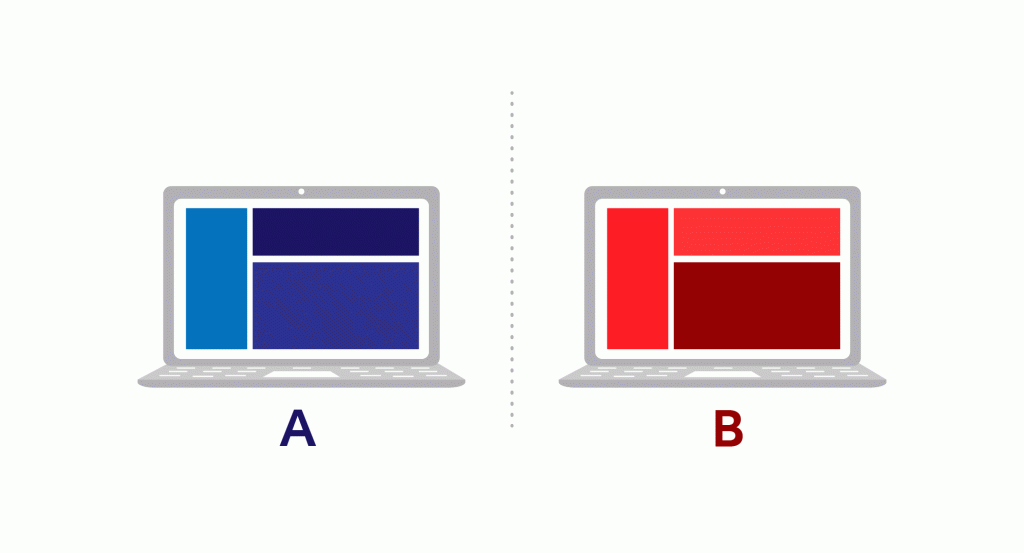
Now that we understand the essentials of cold email outreach, let's proceed to how you can strengthen the core of it, i.e, writing the perfect cold email.
How to Write an Effective Cold Email (With Examples)?
Shane Snow conducted an interesting experiment for his book Smartcuts, where he sent 1,000 cold emails to executives and received virtually no response.
So he tried again with a smaller portion of the same group and had better results by applying a few principles and great advice from people like Adam Grant, Tim Ferriss, and Heather Morgan.
Learning from the experiments and experts, it has been concluded that an effective email cold email should ought these five things:
1. Personalize the message for the recipient - It calls for a lot of research to learn about your target audience. Personalization isn’t just about a generic mention or just adding your recipient’s name to the email.
Personalization is thinking about who the recipient is, how they perceive the world, what interests them, what their pain points are, and what they desire. This shows that you have worked hard to understand them.
So he tried again with a smaller portion of the same group and had better results by applying a few principles and great advice from people like Adam Grant, Tim Ferriss, and Heather Morgan.
Learning from the experiments and experts, it has been concluded that an effective email cold email should ought these five things:
1. Personalize the message for the recipient - It calls for a lot of research to learn about your target audience. Personalization isn’t just about a generic mention or just adding your recipient’s name to the email.
Personalization is thinking about who the recipient is, how they perceive the world, what interests them, what their pain points are, and what they desire. This shows that you have worked hard to understand them.
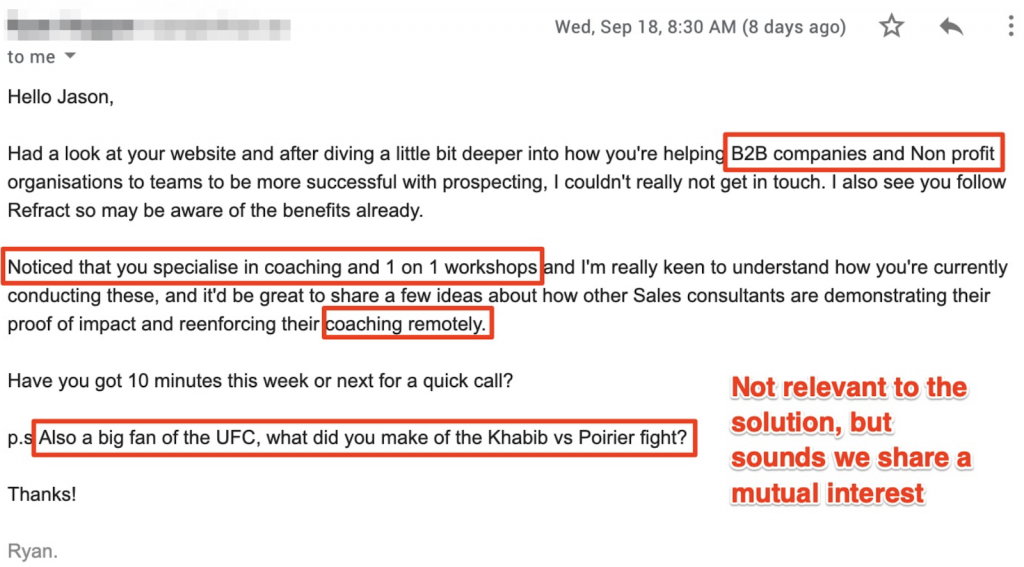
Also, adding why you are emailing them rather than anyone else makes them listen to you more.
This is because people are far more motivated to help you when they believe they are uniquely qualified to do so. You can tell a story that makes sense to them if you outline exactly where they fit in.
This is because people are far more motivated to help you when they believe they are uniquely qualified to do so. You can tell a story that makes sense to them if you outline exactly where they fit in.
2. Establish your credibility – When we meet a stranger or receive an email from one, we want to know who they are and why they are important to us.
Even though you have done a lot of background research on the people you're emailing, they know nothing about you. You must demonstrate your credibility and trustworthiness.
Knowing someone in common is the most powerful type of social proof you can provide. Mention any direct connections you have. You are no longer a stranger if you have a mutual friend. If there are no mutuals, try mentioning how you learned about them via LinkedIn, a social meet, etc.
Depending on the individual or the pitch you make, your authority, credibility, or social standing play a role. Mention such details quickly — a line or two should do it. You are more likely to get a response if you are more "important."
Even though you have done a lot of background research on the people you're emailing, they know nothing about you. You must demonstrate your credibility and trustworthiness.
Knowing someone in common is the most powerful type of social proof you can provide. Mention any direct connections you have. You are no longer a stranger if you have a mutual friend. If there are no mutuals, try mentioning how you learned about them via LinkedIn, a social meet, etc.
Depending on the individual or the pitch you make, your authority, credibility, or social standing play a role. Mention such details quickly — a line or two should do it. You are more likely to get a response if you are more "important."
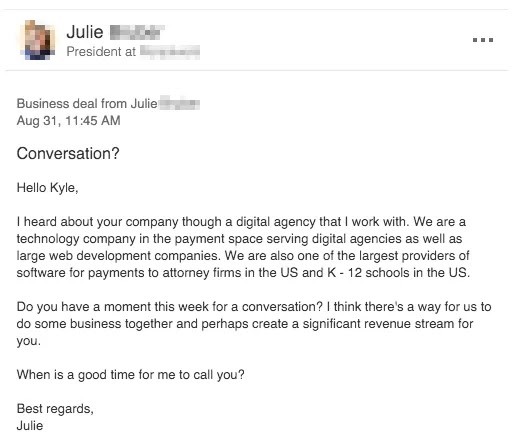
If you don't have such credibility or social proof, try emphasizing the similarities or their interests. Look for exceptional connections, such as hometowns and unusual hobbies. "Similarities matter most when they're rare," says Adam Grant.
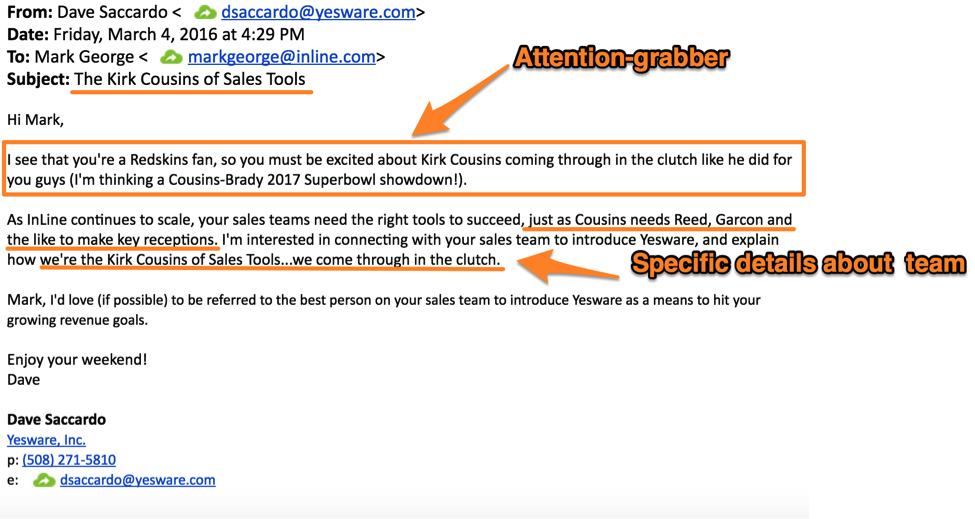
The point is that you want to find a way to transition from "stranger" to "member of the recipient's group."
3. Focus on pain points and provide value – Why would your prospects care about reading your email? The majority of them won't even bother opening your emails if they do not seem to be of any use to them at all.
To make an impact on your prospects, you need to provide something of interest and value in the emails. Your best bet can be to highlight their pain points and then slowly move towards how your product/service can help them improve their situation.
So, do your research, segment your list into groups that might have similar pain points, and provide a solution for them. Make sure to mention the pain point in the subject line so that they are intrigued enough to open the email.
To make an impact on your prospects, you need to provide something of interest and value in the emails. Your best bet can be to highlight their pain points and then slowly move towards how your product/service can help them improve their situation.
So, do your research, segment your list into groups that might have similar pain points, and provide a solution for them. Make sure to mention the pain point in the subject line so that they are intrigued enough to open the email.
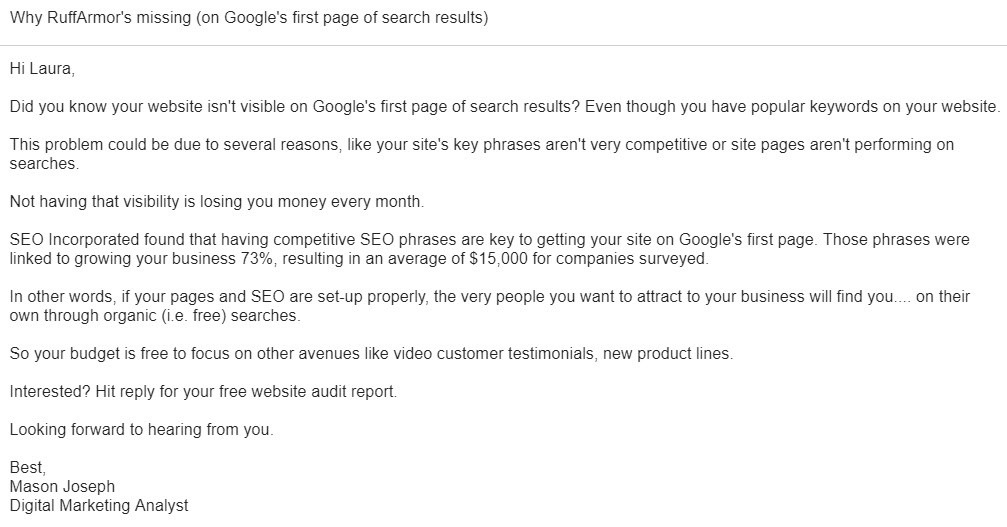
Even if you don't provide a direct solution to the problem, it can still be a good opportunity to build relationships. Try introducing them to the people (in case you are targeting someone specific (decision-makers- CEO, VC, etc). This will bring you to their If you notice, they will be grateful for your help. They might end up showing interest in your offerings or even introduce you to others who might be interested.
If you are targeting a group of people, you can offer them a guide or tips to solve their problem at the end of the email. You can also mention what you offer and how it might help them as well. You will build your credibility this way, and they might become interested in your services after hearing from you.
If you are targeting a group of people, you can offer them a guide or tips to solve their problem at the end of the email. You can also mention what you offer and how it might help them as well. You will build your credibility this way, and they might become interested in your services after hearing from you.
4. Keep your message short and crisp – Honestly, nobody has time to read a 500-word email from a stranger. The emails that are shorter, and to the point get much better responses.
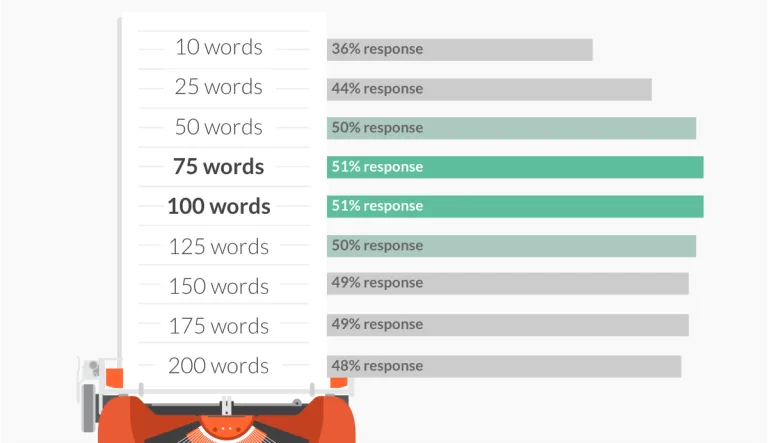
Because you have limited words, you need to be smart and convey just the right message that is intriguing as well.
The best way to keep things short and direct is to write as you would speak.
If you meet someone in person, you wouldn’t just walk up and start pitching them. You’d introduce yourself, say something nice, try to make a connection, and then make a request that makes sense. In short, your emails should sound natural and not like robots.
Think about what would make you different from 10 other people pitching them something similar, and you can entice your reader to respond to you and not the others.
Also, make sure that you make it very clear what “action” you want them to take. How you talk matters. Oh, and never forget to add a CTA that guides them to what you are asking them to do.
The best way to keep things short and direct is to write as you would speak.
If you meet someone in person, you wouldn’t just walk up and start pitching them. You’d introduce yourself, say something nice, try to make a connection, and then make a request that makes sense. In short, your emails should sound natural and not like robots.
Think about what would make you different from 10 other people pitching them something similar, and you can entice your reader to respond to you and not the others.
Also, make sure that you make it very clear what “action” you want them to take. How you talk matters. Oh, and never forget to add a CTA that guides them to what you are asking them to do.
5. Be appreciative and give your prospects a superior position – People like to be appreciated, and this can work in your favor. Even a simple "Thank you so much, I'm grateful" can double response rates.

Also, tell people that it's okay if they are too busy. Giving them an out makes them more likely to help you. This also makes them feel in power and not like they are being forced to do something.
6. Don’t look for templates– If you think copy - pasting a template you found on Google can bring in great results, then you are absolutely WRONG!
No matter how well crafted a template might look for mass outreach, it won’t work.
Why?
Because it is not personalized. (Remember, the more specific and personalized an email is, the better the outcome.)
So, rather than sticking to mass templates, look for examples. Learn from them, then come up with your own email skeleton and personalize it further based on your group of recipients.
No matter how well crafted a template might look for mass outreach, it won’t work.
Why?
Because it is not personalized. (Remember, the more specific and personalized an email is, the better the outcome.)
So, rather than sticking to mass templates, look for examples. Learn from them, then come up with your own email skeleton and personalize it further based on your group of recipients.

Conclusion
Cold emails don't have to make you feel like a fish out of water. Cold outreach can yield lucrative opportunities, provided you reach your prospects and capture their attention.
So, do your research, build your cold outreach strategy, and utilize the power of words. Good Luck!
So, do your research, build your cold outreach strategy, and utilize the power of words. Good Luck!

Recent Posts
08 Jul 2024
Build Prospect Lists on Wellfound (Formerly AngelList) with Clearout Chrome Extension
Looking for startups, funding, investors? Here’s how you can use Clearout Chrome Extension for extra ...
25 Jun 2024
Designing User-friendly Form Error Messages (Best Practices + Examples)
Don’t want to scare your users away? Then you must make your forms user-friendly and clear. Try thes ...
07 Jun 2024
CRM Data Hygiene - Is Your CRM Data Clean & Up-To-Date?
CRM Data Hygiene can largely impact your business. Here’s how you can keep your CRM data clean and u ...
10 May 2024
Buying Email List? Here's Why You Should Not (+6 alternatives)
Don’t fall for buying email lists from untrustworthy and outdated sources. Instead try these ways to ...
03 May 2024
How To Find Phone Numbers From LinkedIn - Explained!
Looking for your prospects on LinkedIn? Here’s how you can find their phone numbers from LinkedIn.
Prospecting, Email Finder & Email Verification Service
Prospecting, Email Finder & Email Verification Service
Reach out to more real customers for your business
Create a free account with 100 credits

